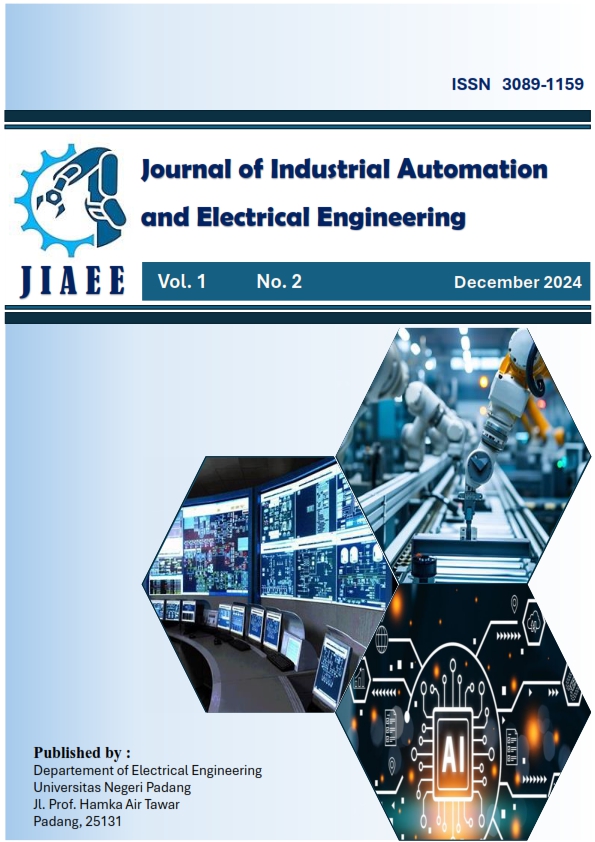Automatic waste sorting and trash bin capacity monitoring system using solar panels based on Internet of Things (IoT)
DOI:
https://doi.org/10.24036/18s5y336Keywords:
Automatic waste sorting , Trash bin capacity , Internet of Things , NodeMCU ESP32 , BlynkAbstract
Waste management is one of the common issues faced by many cities worldwide. Many people dispose of waste carelessly, failing to separate different types of waste, leading to piled-up and scattered garbage. This problem is caused by a lack of public awareness about environmental preservation and the absence of quick access between garbage bins and waste collectors, resulting in waste accumulation. Based on these issues, a smart trash bin based on the Internet of Things was designed using NodeMCU ESP32 as its microcontroller. The bin lid operates automatically using an infrared sensor as an object detector and is equipped with a DFPlayer module that can produce sound. The waste separator uses three proximity sensors and a DHT22 sensor to differentiate between wet organic, dry organic, and inorganic metal and non-metal waste. In this study, a trash bin was also designed with an ultrasonic sensor to detect the bin’s capacity, and the data was then sent via the Blynk platform, allowing waste collectors to access it through a smartphone. From the test results, the three proximity sensors and the DHT22 sensor successfully differentiated between wet, dry, metal, and non-metal waste. The data obtained by the ultrasonic sensor was also successfully transmitted to the collectors via the Blynk application
Downloads
References
[1] Z. Zuraidah, L. N. Rosyidah, and R. F. Zulfi, “Edukasi Pengelolaan Dan Pemanfaatan Sampah Anorganik Di Mi Al Munir Desa Gadungan Kecamatan Puncu Kabupaten Kediri,” Budimas J. Pengabdi. Masy., vol. 4, no. 2, pp. 1–6, 2022, doi: 10.29040/budimas.v4i2.6547
[2] Y. B. Widodo, T. Sutabri, and L. Faturahman, “Tempat Sampah Pintar Dengan Notifikasi Berbasis IOT,” J. Teknol. Inform. dan Komput., vol. 5, no. 2, pp. 50–57, 2019.
[3] I. Isnawaty, S. Subardin, and L. L. Normawan, “Penerapan Internet Of Things (Iot) Pada Sistem Monitoring Tempat Sampah Rumah Tangga Menggunakan Metode Haversine Formula,” Digit. Transform. Technol., vol. 2, no. 2, pp. 35–44, 2022.
[4] A. F. Ikhfa and M. Yuhendri, “Monitoring Pemakaian Energi Listrik Berbasis Internet of Things,” JTEIN J. Tek. Elektro Indones., vol. 3, no. 1, pp. 257–266, 2022.
[5] R. Md, R. H. Sayed and A. Khan Kowshik, "Intelligent Waste Sorting Bin for Recyclable Municipal Solid Waste," 2021 International Conference on Automation, Control and Mechatronics for Industry 4.0 (ACMI), Rajshahi, Bangladesh, 2021, pp. 1-5, doi: 10.1109/ACMI53878.2021.9528157.
[6] D. R. P. Noordi, I. A. Prastowo, M. A. R. Sugiarto, and D. Hartanti, “Perancangan tempat sampah otomatis berbasis arduino,” Hexatech J. Ilm. Tek., vol. 1, no. 2, pp. 51–54, 2022.
[7] M. Ismail, R. K. Abdullah, and S. Abdussamad, “Tempat Sampah Pintar Berbasis Internet of Things (IoT) Dengan Sistem Teknologi Informasi,” Jambura J. Electr. Electron. Eng., vol. 3, no. 1, pp. 7–12, 2021, doi: 10.37905/jjeee.v3i1.8099.
[8] M. Akbar, S. D. Anjasmara, and K. D. K. Wardhani, “Rancang Bangun Alat Pendeteksi Sampah Organik dan Anorganik Menggunakan Sensor Proximity dan NodeMCU ESP8266,” J. Komput. Terap., vol. 7, no. 2, pp. 290–299, 2021, doi: 10.35143/jkt.v7i2.5178.
[9] F. Adani and S. Salsabil, “Internet of Things: Sejarah Teknologi Dan Penerapannya,” Isu Teknol. Stt Mandala, vol. 14, no. 2, pp. 92–99, 2019.
[10] M. Anas, N. Hikmah, and I. Aprilia, “Smart Trash Klasifikasi Sampah Otomatis Dengan Sensor Proximity Berbasis Arduino,” J. FORTECH, vol. 3, no. 2, pp. 64–72, 2023, doi: 10.56795/fortech.v3i2.103.
[11] F. Azmi Hasibuan, Z. Masruro, and S. Tunas Bangsa, “RESOLUSI : Rekayasa Teknik Informatika dan Informasi Penggunaan Sistem Mikrokontroler Dalam Pembuatan Tempat Sampah Pemilah Otomatis Menggunakan Arduino Uno,” Media Online), vol. 1, no. 6, pp. 368–377, 2021.
[12] A. Naufal Maulana and G. Indah Hapsari, “Tempat Sampah Berbicara Otomatis dengan Sensor Ultrasonik Berbasis Arduino Automatic Talking Trash Can Using Ultrasonic Sensor and Arduino,” e-Proceeding Appl. Sci. Vol.7, No.6 Desember 2021, vol. 7, no. 6, pp. 2961–2972, 2021.
[13] A. Irvan Darmansyah, A. Sumardiono, E. Alimudin, and M. Rahayu, “Tempat sampah otomatis berbasis Internet of Things dengan penyulangan hybrid PV-grid,” JITEL (Jurnal Ilm. Telekomun. Elektron. dan List. Tenaga), vol. 1, no. 2, pp. 189–200, 2021, doi: 10.35313/jitel.v1.i2.2021.189-200.
[14] F. O. Dayera, Musa Bundaris Palungan, “G-Tech : Jurnal Teknologi Terapan,” G-Tech J. Teknol. Terap., vol. 8, no. 1, pp. 186–195, 2024.
[15] R. Rahmansa et al., “Sistem Monitoring Kapasitas Sampah Pada Bak Sampah Secara Real-Time Berbasis Internet of Things,” Digit. Transform. Technol. | e, vol. 3, no. 1, pp. 74–82, 2023







